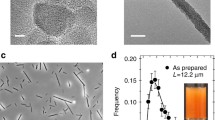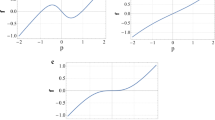Abstract
Flow orientation of bovine brain microtubules has been studies using phase-modulation detected linear dichroism, LD, in a Couette cell with radial light propagation. LD could be sensitively measured in a wide flow gradient interval: 10-3–103 s-1, without any apparent degradation of the microtubule structure. An extremely small flow gradient, 10-3 s-1 is sufficient to give significant orientation, and 10 s-1 rapidly produced a very high degree of orientation. It is also shown that thermal convection effectively orients microtubules in vitro.
The apparent linear dichroism is dominated by an anisotropic scattering from the aligned microtubules, superimposed on a weaker absorption dichroism due to intrinsic chromophores. The linear dichroism due to anisotropic turbidity, LDτ, is found to be an excellent tool for monitoring the formation of microtubules and in contrast to ordinary turbidity measurements, non-specific aggregates contribute to a far less extent.
Time resolved LDτ was used to study the orientational relaxation of microtubules upon stopped shear. The relaxation towards random orientation can be described by a slow, multi-exponential decay. With increasing protein concentration the relaxation becomes slower and above approximately 1 mg/ml a fraction with a semipermanent orientation is formed. Finally, the development of orientation with time upon applying a small, constant gradient has been measured and the results are considered in terms of a model for flow orientation of rigid rods.
Similar content being viewed by others
References
Borisy GG, Olmsted JB, Marcum JM, Allen C (1974) Microtubule assembly in vitro. Fed Proc Am Soc Exp Biol 33:167–174
Bradford C (1976) A rapid and sensitive method for the quantitation of microgram quantities of protein utilizing the principle of protein-dye binding. Anal Biochem 72:248–254
Broersma S (1960) Rotational diffusion constant of cylindrical particles. J Chem Phys 32:1626–1631
Davidson A, Nordén B (1976) Aspects on the conversion of Legrand-Grosjean circular dichroism spectrometers to linear dichroism. Chem Scr 9:49–53
Deinum J, Wallin M, Lagercrantz C (1981) Spatial separation of the two essential thiol groups and the binding-site of the exchangeable GTP in brain tubulin. A spin label study. Biochim Biophys Acta 671:1–8
Deinum J, Wallin M, Jensen WA (1985) Biochim Biophys Acta 838:197–205
Dustin P (1984) Microtubules. Springer, Berlin Heidelberg New York
Fredericq E, Houssier C (1973) Electric dichroism and electric birefringence. Oxford University Press, London
Gaskin F, Cantor CR, Shelanski ML (1974) Turbidimetric studies of the in vitro assembly and disassembly of porcine neurotubules. J Mol Biol 89:737–758
Gethner JS, Gaskin F (1978) Dynamic light scattering from solutions of microtubules. Biophys J 24:505–515
Haga T, Abe J, Kurokawa M (1974) Polymerization and depolymerization of microtubules in vitro as studied by flow birefringence. FEBS Lett 39:291–295
Hall SB, Schellman JA (1982) Flow dichroism of Capsid DNA phages. I. Fast and slow T4B. Biopolymers 21:1991–2010
Higashi S, Kasai M, Oosawa F (1963) Ultraviolet dichroism of F-actin oriented by flow. J Mol Biol 7:421–430
Hofrichter J, Eaton WA (1976) Linear dichroism of biological chromophores. Annu Rev Biophys Bioeng 5:511–531
Kasai M, Oosawa F (1972) Flow birefringence. Methods Enzymol 26:289–323
Kristofferson D, Purich DL (1981) Time scale of microtubule length redistribution. Arch Biochem Biophys 211:222–226
Matsuoka Y, Nordén B (1982) Linear dichroism studies of nucleic acid bases in stretched poly(vinyl alcohol) film. Molecular orientation and electronic transition moment directions. J Phys Chem 86:1378–1386
Mayfield JE, Bendet IJ (1970) Quantitative flow dichroism. I. Correction for disorentation in a solution of rods. Biopolymers 9:655–668
Meeten GH (1981) Conservative dichroism in the Rayleigh-Gans-Debye approximation. J Colloid Interf Sci 84:235–239
Nordén B (1978) Applications of linear dichroism spectroscopy. Appl Spectrosc Rev 14(2):157–248
Nordén B, Seth S (1985) Critical aspects of measurement of circular and linear dichroism. A device for absolute calibration. Appl Spectrosc Rev 39:647–655
Nordén B, Tjerneld F (1976) High sensitivity linear dichroism as a tool for equilibrium analysis in biochemistry stability constant of DNA ethididium bromide complex. Biophys Chem 4:191–198
Nordén B, Tjerneld F (1982) Structure of methylen blue-DNA complexes studied by linear and circular dichroism spectroscopy. Biopolymers 21:1713–1734
Pollard TD (1982) A falling ball apparatus to measure filament cross linking. Methods Cell Biol 24:301–311
Tanichuchi M, Kuriyama R (1978) Ultraviolet flow dichroism of brain microtubules. Biochim Biophys Acta 533:538–541
Thulstrup EW (1980) Aspects of the linear and magnetic circular dichroism of planar organic molecules. In: Berthier G, Dewar MJS, Fischer H, Fukuii K, Hartmann H, Jaffe HH, Jortner J, Kutzelnigg W, Ruedenberg K, Scrocco E, Zeil W (eds) Lecture Notes in Chemistry, Vol 14. Springer, Berlin Heidelberg New York
Wada A (1972) Dichroic spectra of biopolymers oriented by flow. Appl Spectrosc Rev 6:1–29
Wada A, Kozawa S (1964) Instrument for the studies of differential flow dichroism of polymer solutions. J Polymer Sci A 2:853–864
Wilson R, Schellman J (1978) The flow linear dichroism of DNA: comparison with the bead spring theory. Biopolymers 17:1235–1248
Author information
Authors and Affiliations
Rights and permissions
About this article
Cite this article
Nordh, J., Deinum, J. & Nordén, B. Flow orientation of brain microtubules studies by linear dichroism. Eur Biophys J 14, 113–122 (1986). https://doi.org/10.1007/BF00263068
Received:
Accepted:
Issue Date:
DOI: https://doi.org/10.1007/BF00263068




